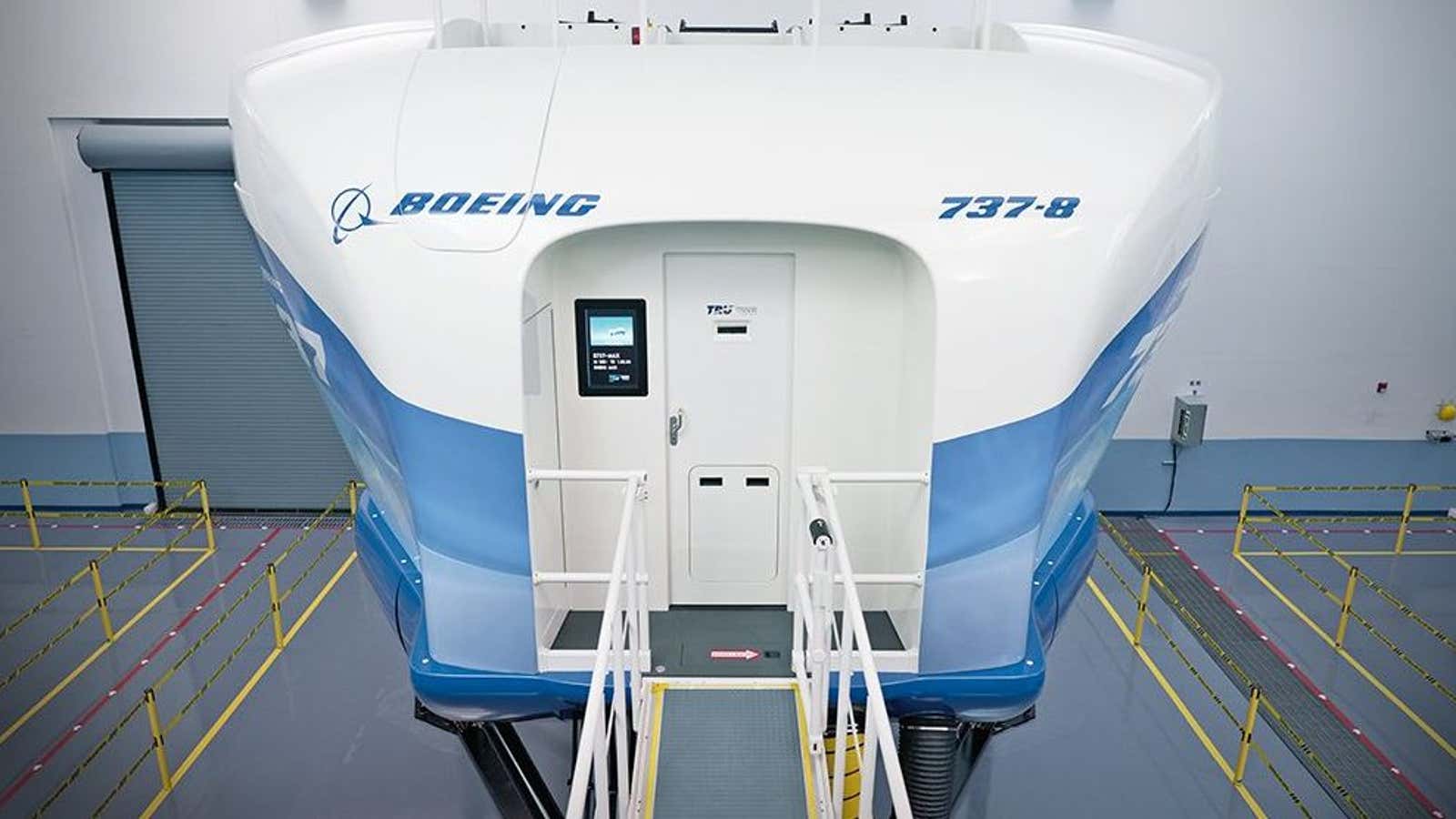US pilots got an extra hour or two of training to prepare to use Boeing’s new 737 Max 8 aircraft, which has been involved in two deadly crashes in less than six months.
The first crash involved a Lion Air flight in Indonesia that plunged into the sea soon after takeoff in October last year, killing all 189 on board. A week ago, an Ethiopian Airlines flight crashed six minutes after taking off, killing 157 people. After the second crash, China grounded the aircraft, and was quickly followed by other nations. The US Federal Aviation Administration initially allowed airlines in the US to keep flying the plane, but on Wednesday (March 13) grounded both the Max 8 and Max 9 models, citing refined satellite data and “physical evidence” found at the scene that showed similarities between the two crashes.
The aircraft was developed to include changes to the flight control system that would sharply pitch the plane’s nose down if the onboard computer sensed an imminent stall. The system, known as the Maneuvering Characteristics Augmentation System, or MCAS, was incorporated because the plane has larger engines placed further forward on the craft, and so has a chance of facing a stall at lower speeds than earlier 737 variations. In the Lion Air flight, pilots appeared to be fighting against the system before the aircraft crashed, according to the preliminary accident report.
In the US, Southwest Airlines has 31 of the 737 Max planes, American Airlines 24, and United 14, according to Boeing data through February. Dennis Tajer, spokesman for the American Airlines pilot union, told Quartz that the training prior to the Lion Air crash for pilots qualified to fly the 737-800 amounted to “an iPad lesson for an hour.” Since the Lion Air crash, he said, pilots have had training with an instructor, and pilots have also “requested, if not demanded, simulators.”
In a statement, American Airlines said, “Boeing 737-800 pilots were required to receive some additional training on the MAX 8, which included an hour lesson on some differences. Additional training was not required, as the 737-800 and the MAX 8 have same type certification.”
A New York Times report (paywall) said pilots at United put together a 13-page guide to the 737 Max, which did not mention the MCAS, as well as taking a two-hour iPad lesson about the plane.
Because the FAA deems the 737 Max 8 to be a variant of an already certified aircraft, the 737-800, it limits the amount of separate training required for the Max for pilots already certified to fly the older plane. The FAA didn’t mark out MCAS in its documentation comparing the 737 Max 8 and the 737-800, meant to guide training for the Max, as a difference.
Pilots have said they first became aware of the new flight system after the Lion Air crash, when the FAA ordered 737 Max manuals to be updated and Boeing issued information directing airlines to override procedures.
The FAA said in a statement to Quartz Sunday (March 17) that while “training requirements do not address the MCAS by name, the requirements do include the knowledge to deal with an MCAS event.”
Pilots of all models of airlines are required to undergo training in full flight simulators to know how to override “runaway stabilizer trim”—a term to refer to movements redirecting the plane’s nose that are not activated by the pilot. “A nose-down scenario resulting from an issue with the MCAS system would have the same characteristics,” the FAA noted, and would have to be dealt with in the same way.
The US approach differs from that taken by Brazil, where regulators highlighted a number of changes to pilots, including MCAS, and required training for it, also via video tutorial (paywall).
US pilots have maintained, up until the FAA grounding of the Max, that they felt confident in their ability to fly the plane safely. Tajer noted that American has flown thousands of flights on the 737 Max—American Airlines says it has flown nearly 18,000 flights using it—and none of them has had the kind of equipment indications that preceded the activation of MCAS ahead of the Lion Air crash.
American added it has ordered a 737 Max 8 simulator that it expects to arrive in December. The New York Times reported that United expects to get a simulator in early 2020.
Some airlines in other nations already have simulators. Icelandair has received a simulator from US-based Tru Simulation + Training, while Air Canada—the third biggest airline recipient of the 737 Max—was the first carrier to have a qualified simulator for it, courtesy Canada’s CAE, a month before it received the first of its fleet of 23. A number of airlines in China have ordered full-flight simulators, but it’s unclear if pilots are being trained on them yet. In addition, Tru has provided simulators to Boeing for its training centers in Miami (1), Shanghai (1), Singapore (1), and in the UK (2).
British pilot Chris Brady, author of the Boeing 737 Technical Site, an open-source guide to the 737 family, said the gold standard would be “to get the data from Boeing about what an MCAS fault looks like and have the simulator programmed to look like that.”
He noted that while pilots might be perfectly able to recite a procedure if asked for it by name, in the cockpit “it’s not as cut and dried as you might think it will be.” In the Lion Air case, he said, the pilots “saw all kinds of indicators looking wrong—which do you address first?”
“Have all pilots go through that training in the simulator,” he added. “Then if it happens [they] can handle this.”
Read more of Quartz’s coverage of the Boeing 737 Max crisis.
